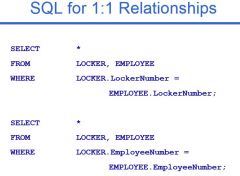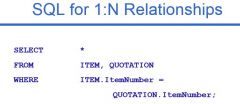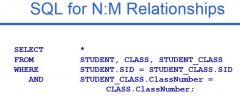![]()
![]()
![]()
Use LEFT and RIGHT arrow keys to navigate between flashcards;
Use UP and DOWN arrow keys to flip the card;
H to show hint;
A reads text to speech;
17 Cards in this Set
- Front
- Back
|
Define functional dependency |
The relationship(within the relation) that describes how the value of one attribute may be used to find the value of another attribute |
|
|
Define determinant |
The attribute that can be used to find the value of another attribute in the relation.
The right hand side of a functional dependency |
|
|
What can the value of a candidate key be used for? |
To find the value of every other attribute in a table |
|
|
A simple candidate key consists of how many attributes? |
Only one |
|
|
A composite candidate key consists of how many attributes? |
More than one |
|
|
* A relation is considered normalized when: |
Every determinant is a candidate key
(Boyce-Codd Normal Form BCNF) |
|
|
SQL for 1:1 relationship |

|
|
|
In a 1:N relationship, the foreign key should always be placed on what side of the relationship? |
The many side
-The 1 side is the parent
-the N side is the child |
|
|
SQL for 1:N Relationship |

|
|
|
To create a N:M Relationship, what must be done |
A intersection table must be created |
|
|
Define an intersection table |
Has a composite key consisting of the keys from each of the tables that it connects. |
|
|
SQL for N:M Relationship |

|
|
|
When an intersection table has columns beyond those in the primary key, the relationship is called a(n) what? |
Association relationship |
|
|
How to represent supertype/subtype relationship? |

|
|
|
SQL For a 1:1 recursive relationship |

|
|
|
SQL For a 1:N recursive relationship |

|
|
|
SQL For a N:M recursive relationship |

|

